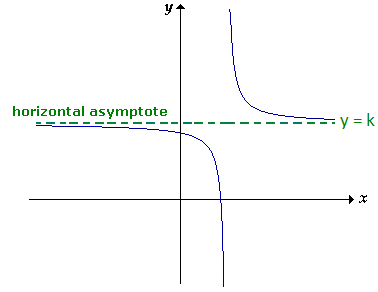HOW TO FIND HORIZONTAL ASYMPTOTE OF A FUNCTION
Horizontal Asymptote :
This is an horizontal line that is not part of a graph of a function but guides it for x-values 'far' to the right and/or 'far' to the left.
The graph may cross it but eventually, for large enough or small enough values of x, that is
x ---> ±∞
Always, the graph would get closer and closer to the horizontal asymptote without touching it.

In the diagram above, y = k is an horizontal asymptote. Because, the graph is getting closer and closer to y = k without touching it as x ---> ±∞.
We can find horizontal asymptotes of a function, only if it is a rational function.
That is, the function has to be in the form of
Rational Function - Example :
How to Find the Equation of an Horizontal Asymptote of a Rational Function
Let y = f(x) be the given rational function. Compare the largest exponent of the numerator and denominator.
Case 1 :
If the largest exponents of the numerator and denominator are equal, equation of horizontal asymptote is
y = ᵃ⁄b
Here a and b are the coefficients of largest exponent terms at the numerator and denominator respectively.
Case 2 :
If the largest exponent of the numerator is less than the largest exponent of the denominator, equation of horizontal asymptote is
y = o (or) x-axis
Case 3 :
If the largest exponent of the numerator is greater than the largest exponent of the denominator, there is no horizontal asymptote and there is only slant asymptote or oblique.
What if the function is not a rational function?
Working rule to find horizontal asymptote, if y = f(x) is not a rational function.
Take the limit x --->+∞ in y = f(x).
Case 1 :
When x ---> ±∞, let y ---> k.
Then, the horizontal asymtote is
y = k
Case 2 :
When x ---> ±∞, let y --->±∞.
Then, there is no horizontal asymptote.
In each case, find the equation of horizontal asymptote.
Example 1 :
Solution :
Step 1 :
In the given rational function, the largest exponent of the numerator is 0 and the largest exponent of the denominator is 1.
Step 2 :
Clearly largest exponent of the numerator is less than the largest exponent of the denominator.
So, equation of the horizontal asymptote is
y = 0 (or) x-axis
Example 2 :
Solution :
Step 1 :
In the given rational function, the largest exponent of the numerator is 2 and the largest exponent of the denominator is 2.
Step 2 :
Clearly, the exponent of the numerator and the denominator are equal.
Step 3 :
Now, to get the equation of the horizontal asymptote, we have to divide the coefficients of largest exponent terms of the numerator and denominator.
So, equation of the horizontal asymptote is
y = ¹⁄₁
y = 1
Example 3 :
Solution :
Step 1 :
In the given rational function, the largest exponent of the numerator is 2 and the largest exponent of the denominator is 1.
Step 2 :
Clearly, the largest exponent of the numerator is greater than the largest exponent of the denominator.
Step 3 :
Because the largest exponent of the numerator is greater than the largest exponent of the denominator, there is no horizontal asymptote.
Example 4 :
Solution :
Step 1 :
Convert the mixed expression on the right side to rational expression.
Step 2 :
In the given rational function, the largest exponent of the numerator is 1 and the largest exponent of the denominator is also 1.
Step 3 :
Clearly, the exponent of the numerator and the denominator are equal.
Step 4 :
Now, to get the equation of the horizontal asymptote, we have to divide the coefficients of largest exponent terms of the numerator and denominator.
So, equation of the horizontal asymptote is
y = ⁶⁄₁
y = 6
Example 5 :
y = ex
Solution :
When x ---> -∞,
When x ---> +∞,
When x ---> -∞, ex ---> 0.
When x ---> +∞, ex ---> +∞.
When x tends to -∞, ex tends to a finite value 0.
That is,
x ---> -∞, y ---> 0
Therefore, the horizontal asymptote is
y = 0
Example 6 :
y = e-x
Solution :
When x ---> -∞,
When x ---> +∞,
When x ---> -∞, e-x ---> +∞.
When x ---> +∞, e-x ---> 0.
When x tends to +∞, e-x tends to a finite value 0.
That is,
x ---> +∞, y ---> 0
Therefore, the horizontal asymptote is
y = 0
Example 7 :
Solution :
When x ---> -∞,
When x ---> +∞,
When x ---> ±∞,
When x tends to ±∞, e¹⁄ₓ tends to a finite value 1.
That is,
x ---> ±∞, y ---> 1
Therefore, the horizontal asymptote is
y = 1
Kindly mail your feedback to v4formath@gmail.com
We always appreciate your feedback.
©All rights reserved. onlinemath4all.com
Recent Articles
-
Digital SAT Math Problems and Solutions (Part - 150)
Apr 25, 25 11:46 AM
Digital SAT Math Problems and Solutions (Part - 150) -
AP Calculus AB Problems with Solutions (Part - 19)
Apr 24, 25 11:10 PM
AP Calculus AB Problems with Solutions (Part - 19) -
AP Calculus AB Problems with Solutions (Part - 18)
Apr 24, 25 11:06 PM
AP Calculus AB Problems with Solutions (Part - 18)
